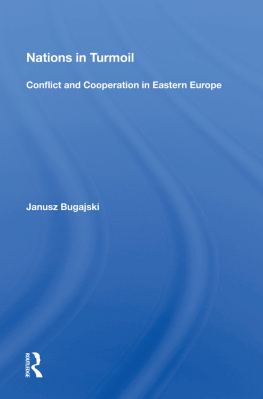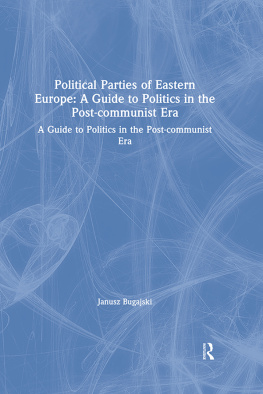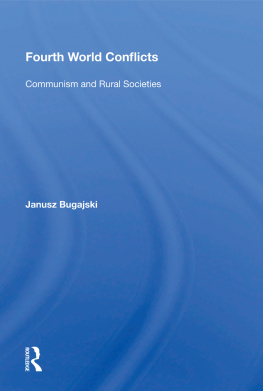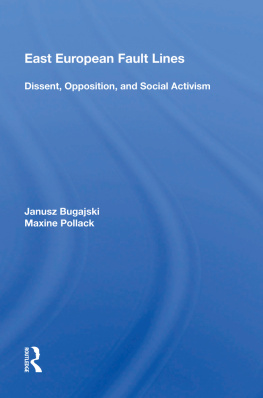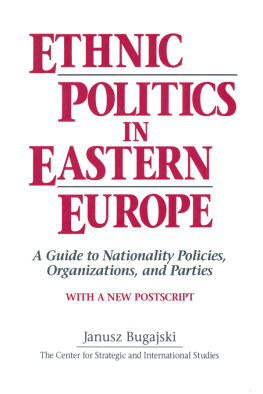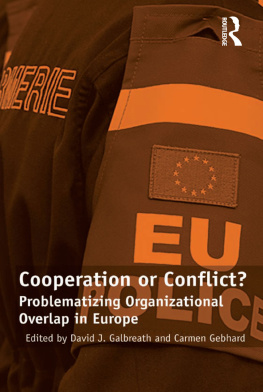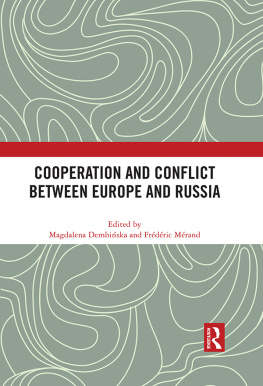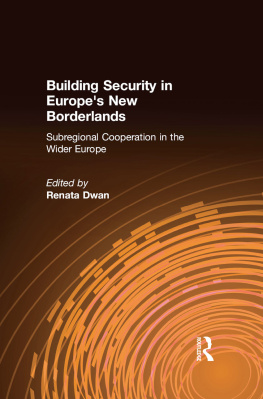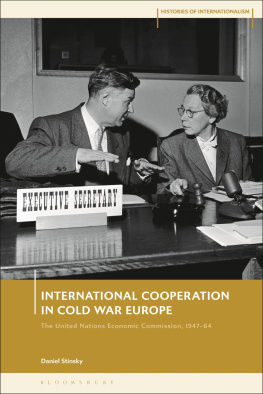Nations in Turmoil
Conflict and Cooperation in Eastern Europe
Janusz Bugajski
First published 1993 by Westview Press
Published 2018 by Routledge
52 Vanderbilt Avenue, New York, NY 10017
2 Park Square, Milton Park, Abingdon, Oxon OX14 4RN
Routledge is an imprint of the Taylor & Francis Group, an informa business
Copyright 1993 by Taylor & Francis
All rights reserved. No part of this book may be reprinted or reproduced or utilised in any form or by any electronic, mechanical, or other means, now known or hereafter invented, including photocopying and recording, or in any information storage or retrieval system, without permission in writing from the publishers.
Notice:
Product or corporate names may be trademarks or registered trademarks, and are used only for identification and explanation without intent to infringe.
Library of Congress Cataloging-in-Publication Data
Bugajski, Janusz, 1954
Nations in turmoil: conflict and cooperation in Eastern Europe /
Janusz Bugajski.
p. cm.
ISBN 0-8133-1626-X
1. Europe, EasternPolitics and government1989
2. NationalismEurope, Eastern. 3. Europe, EasternEthnic
relations. I. Title.
DJK51.B84 1993
940'.09717dc20 92-24761
CIP
ISBN 13: 978-0-367-00265-7 (hbk)
To Aimee, my inimitable colleague and friend, for making it all possible
This book is the culmination of two years of extensive travel to all the countries, old and new, in eastern Europe. I would like to thank all of the organizations that helped to sponsor my trips and the colleagues who shared my adventures. Indispensable research assistance for various parts of the project was provided by a host of students, including Elizabeth Krzysik, Lesley Seplaki, John Lazas, Olga Milosavljevic, Michelle Heald, Christopher Beecroft, Allan Hoffman, Kim Brinck-Johnsen, Elena Ciura DeCastris, Natasha Mylroie, Becky Siahaya, Sean Harris, Eric Bruder, Gisele Grayson, Anne Nisenson, Sarah Despres, Ann Horvath, Marianne Oglo, Susan Penksa, John Kenny, Karin Orsic, Dimitry Osipov, Nancy Oglo, and Viden Nedialkov. My special gratitudefor help above and beyond the call of dutymust go to my research and administrative assistants at the Center for Strategic and International Studies in Washington, D.C., Aimee Breslow, Darcy Zajacek, and Anne Truslow.
Janusz Bugajski
Washington, D.C.
The east European region has undergone breathtaking changes since the Soviet empire began to unravel at the close of the 1980s. The rapid disintegration of the unpopular and illegitimate Communist regimes was accompanied by a democratic upsurge in each state. But the painstaking process of reform and reconstruction heralded a prolonged period of political turbulence, economic uncertainty, and international instability. Ethnic and nationality tensions also resurfaced throughout the region, as the new governments grappled with the aspirations of disgruntled minorities and the problem of implementing independent foreign policies and devising new security arrangements. This book attempts to establish the contours and dimensions of international conflict and cooperation in eastern Europe during the early post-Communist period. It explores the roots and branches of ethnic and nationality relations throughout the region and focuses on the most contentious internal and inter-state issues. To place the subject matter in context, it is valuable to begin with an overview of political and economic developments in the region since the collapse of Communist Party rule and the demolition of the Soviet bloc.
With the dismantling of the one party state, systemic political and economic reforms were launched in each country, although with varying degrees of intensity. Structural transformations were deemed essential for rescuing the region's bankrupt economies, building sound and durable political institutions, enhancing public participation, and gaining Western financial assistance and foreign business investment. Each new administration drew upon diverse constitutional and legislative procedures from the Western democracies, and its own independent pre-Communist traditions in constructing a democratic parliamentary system of government. A broad assortment of political parties and coalitions replaced the crumbling one-party systems throughout eastern Europe. They were formed on the basis of the nation's existing social constituencies, interest groups, and emerging ideological trends. But as political and government controls were eliminated from virtually all spheres of public life, new social tensions have been generated as a result of deteriorating economic conditions and the unsteady emergence of pluralistic political systems. In some cases, disputes were also sparked over domestic divisions based on ethnicity or regionalism, as well as over the foreign policies of the newly elected governments and their evolving relations with neighboring states.
Given this context, four important variables must be considered in order to understand eastern Europe's current predicament and to trace the evolution of international relations in the region since the fall of Communism: domestic political developments, market-oriented economic reforms, ethnic and nationality relations, and changing international conditions.
Some states have moved faster than others on the political front, even though each country has held multi-party general and local elections during the past two years. The first national elections had the character of a plebiscite to legitimately break the Communist stranglehold on power; forthcoming ballots will help to crystallize the political constellations and profiles of each state. Most of the Balkan countries have remained at the rear of the democratization process, although political pluralism has clearly taken root and the reformed Communists are unlikely to retain or regain exclusive power anywhere in the region. Nevertheless, the dislodging of the old political apparatus from each important institution, particularly at local administrative levels, has proven to be a slower process in Romania, Bulgaria, and Albania than in the central European states of Poland, Hungary, and the Czech and Slovak Federal Republic. Yugoslavia has occupied an intermediary political position, as the pace of democratic change has differed between the country's six republics and this in turn, has also contributed to undermining the existence of the multi-national federation.
While democracy has remained only partially embedded in the institutional fabric of most of these sovereign nation-states, power struggles have continued to be waged both inside and outside the new political structures. Such contests are evident either between the former oppositionist activists and the ex-Communist reformers, who have adapted to the new political landscape (observable in Bulgaria, Albania, and Romania), or within the former dissident circles (as witnessed in the fracturing of Poland's Solidarity, the Czech Civic Forum, and Slovakia's Public Against Violence). These conflicts have been partly ideological and programmatic, but often involved a marked degree of personal ambition and mutual animosity. To fully decipher these political conflicts, analysts needed to look beyond the theories of democratic transformation by examining the biographies and personalities of the leading political actors.
Political competition may, of course, be a healthy process if it does not imperil the process and progress of democracy, and the competitors remain publicly accountable and subject to a system of laws and regulations. However, a clear danger in eastern Europe is the likelihood that political life will remain splintered into a broad spectrum of minute, weak and uninfluential parties. This would make stable governments difficult to sustain. Political parties are still constructed largely around personalities and friendship connections rather than distinct programs and platforms, and the majority of organizations lack a solid material foundation. The ideal solution would be the emergence of a handful of reasonably strong parties, spanning the traditional political spectrum and representing the interests of specific sectors of society. In fact, many of the new mini-parties are likely to fall by the wayside, others will coalesce, and a few will expand substantially. In the interim, unsteady governing alliances, hastily arranged between a plethora of small parties, may remain hesitant or hamstrung in undertaking or pursuing any significant economic and foreign policy, initiatives.


